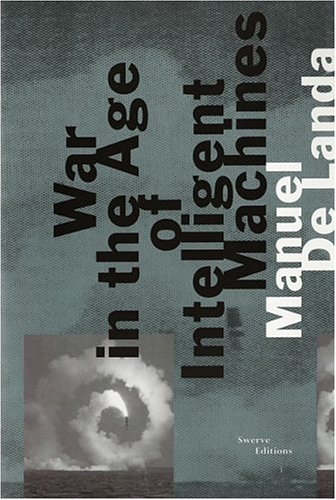Jordan Crandall (ed.): Under Fire 1 & 2. The Organization and Representation of Violence (2005)
Filed under book | Tags: · art, democracy, journalism, mass media, military, politics, war

Through a series of discussions about an array of issues–battle simulation techniques and news programming, democracy and violence, the privatization of the military, and militarized bodies–Jordan Crandall explores the organization and representation of contemporary armed conflict. Moderated by Crandall, Under Fire 1 is a compilation of a series of dialogues that occurred online from January 25 through April 19, 2004 between artists, political scientists, critics, activists, and journalists around the central theme.
Publisher Witte de With, Rotterdam, 2005
ISBN 90-73362-61-X
Length 96 pages

Under Fire 2 is the second collection edited by Jordan Crandall in an ongoing project that explores the organization and representation of armed conflict. Emerging from online dialogues among a group of artists, theorists, scientists, critics, activists, and journalists during three months of 2004 and reorganized thematically, the discussions in Under Fire 2 aim to offer new insights into symptomatic violence. The book covers issues such as the privatization of the military and the contributions of commercial and independent news media, as well as representations from artistic, literary, and popular entertainment sources, to our cultural perception of conflict. Rather than relying on discourses based on Western conceptions of modernity, the project is dedicated to opening up new historical perspectives, exploring the potential of Islamist points of view as sources of critical and political debate.
Publisher Witte de With, Rotterdam, 2005
ISBN 9073362652, 9789073362659
Length 112 pages
More info (author)
More info (project site)
More info (publisher)
More info (vol 1; google books)
More info (vol2; google books)
Manuel DeLanda: War in the Age of Intelligent Machines (1991)
Filed under book | Tags: · abstract machine, arpanet, artificial intelligence, expert systems, machine, military, robots, technology, turing machine, war

“In the aftermath of the methodical destruction of Iraq during the Persian Gulf War, the power and efficiency of new computerized weapons and surveillance technology have become chillingly apparent. For Manuel De Landa, however, this new weaponry has a significance that goes far beyond military applications: he shows how it represents a profound historical shift in the relation of human beings both to machines and to information. The recent emergence of “intelligent” and autonomous bombs and missiles equipped with artificial perception and decision-making capabilities is, for De Landa, part of a much larger transfer of cognitive structures from humans to machines in the late twentieth century.
In this remarkable book, De Landa provides a rich panorama of these astonishing developments. He details the mutating history of information analysis and machinic organization from the mobile siege artillery of the Renaissance, the clockwork armies of the Thirty Years War, the Napoleonic campaigns, and the Nazi blitzkrieg up to present-day cybernetic battle-management systems and satellite reconnaissance networks. Much more than a history of warfare, De Landa provides an unprecedented philosophical and historical reflection on the changing forms through which human bodies and materials are combined, organized, deployed, and made effective.”
Publisher Zone Books, 1991
ISBN 0942299752
271 pages
PDF (15 MB, updated on 2016-7-18)
Comment (0)Gene Ray: Terror and the Sublime in Art and Critical Theory: From Auschwitz to Hiroshima to September 11 (2005)
Filed under book | Tags: · art history, critical theory, military, war on terror

The eleven interconnected essays of this book penetrate the dense historical knots binding terror, power, and the aesthetic sublime and bring the results to bear on the trauma of September 11 and the subsequent “war on terror.” Through rigorous critical studies of major works of post- 1945 and contemporary culture, the book traces transformations in art and critical theory in the aftermath of Auschwitz and Hiroshima. Critically engaging with the work of continental philosophers Theodor W Adorno, Jacques Derrida, and Jean-Francois Lyotard and of contemporary artists Joeph Beuys, Damien Hirst, and Boaz Arad, the book confronts the shared cultural conditions that made Auschwitz and Hiroshima possible and offers searching meditations on the structure and meaning of the traumatic historical “event.” Ray argues that globalization cannot be separated from the collective tasks of working through historical genocide. He provocatively concludes that the curent US-led “war on terror” must be grasped as a globalized inability to mourn.
Contents:
Introduction: The Hit * Reading the Lisbon Earthquake: Adorno, Lyotard, and the Contemporary Sublime * Joseph Beuys and the “After-Auschwitz” Sublime * Ground Zero: Hiroshima Haunts 9/11 * Mirroring Evil: Auschwitz, Art, and the “War on Terror” * Little Glass House of Horror: Taking Damien Hirst Seriously * Blasted Moments: Remarking a Hiroshima Image * Installing a “New Cosmopolitics”: Derrida and the Writers * The Trauerspiel in the Age of Its Global Reproducibility: Boaz Arad’s Hitler Videos * Listening with the Third Ear: Echoes from Ground Zero * Conditioning Adorno: “After Auschwitz” Now
Published by Palgrave Macmillan, 2005
ISBN 140396940X, 9781403969408
188 pages
More info (publisher)
More info (google books)

